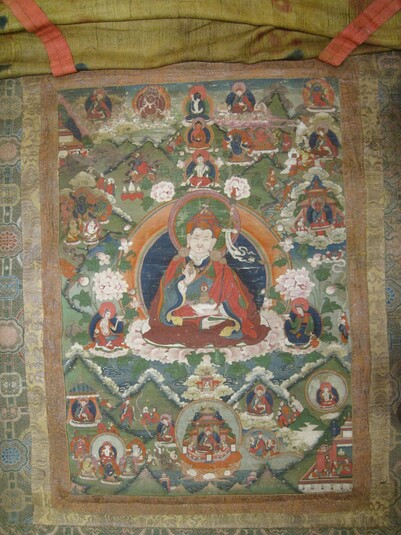
Item: Padmasambhava - (Main Form)
| Origin Location | Tibet |
|---|---|
| Date Range | 1800 - 1899 |
| Lineages | Nyingma and Buddhist |
| Material | Ground Mineral Pigment on Cotton |
| Collection | Field Museum of Natural History |
Padmasambhava (Tibetan: pe ma jung ne. English: Lotus Born): also known as Guru Rinpoche (Precious Teacher).
 Pemasambhava
Pemasambhava  Pema Jungne
Pema Jungne  Biographical Information [TBRC]
Biographical Information [TBRC]
Considered by many Tibetan Buddhists as principal among the many teachers to bring Buddhism to Tibet in the 8th century, Padmasambhava has numerous forms representing outer, inner and secret aspects of his spiritual being. Within the Oral (Kama) Tradition of the Nyingma Tradition of Tibetan Buddhism, Padmasambhava was born in Northern India as the son of a king or minister. In the 'Revealed Treasure' (Terma) Tradition he was born on a lotus in Dhanakosha lake as an emanation of the Buddha Amitabha. There is also evidence that Padmasambhava came from South India and that he was the brother-in-law of the Indian Abbott Shantirakshita, builder of the first monastery in Tibet - Samye Chokor Ling. (See Padmasambhava Life-story Painting).
The images in the painting above depict the teachings and visual forms as described in the 'Revealed Treasure' (terma) teaching, of the Nyingma Tradition of Tibetan Buddhism, known as the Ngar Pan Yontan Dzo. (See other paintings depicting this same subject matter).
Jeff Watt 7-2010
Padmasambhava: Ngari Panchen Yontan Terdzo
Collection of the Field Museum of Natural History (Painting)
